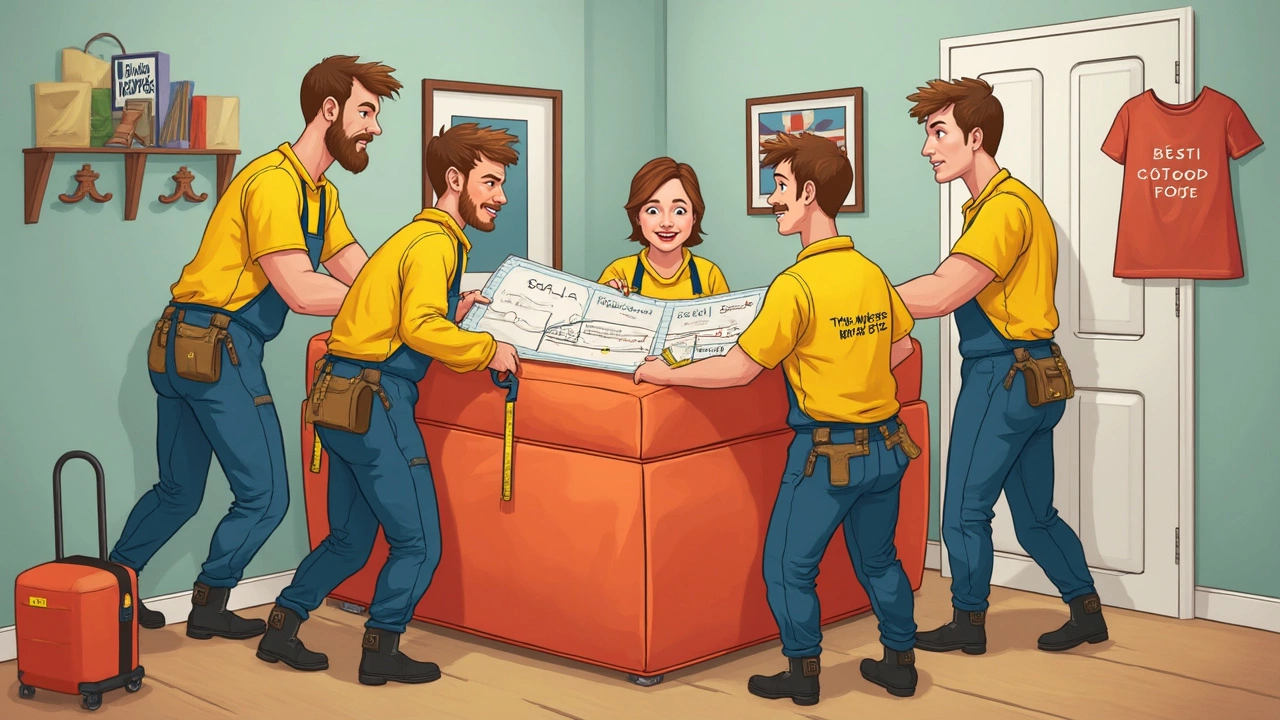Picture this: you find the perfect corner sofa that ticks every box—super comfy, right color, just calling your name. But before you even think about hitting 'order', you have to be sure it won’t get stuck halfway around the hallway bend. Nobody wants the embarrassment of calling in neighbors because the new couch is wedged like a stubborn mule between two walls.
Start simple. Grab a tape measure—not your neighbor’s rusty old one, but one that works. Measure every single spot the couch will pass through. Hallways, doorways, corners—even quirky turns you stopped noticing ages ago. Write the numbers down, don’t trust your memory. Sofas always look smaller in the showroom and way bigger when they’re towering over your staircase. If your hallway or corner is narrow, take a moment to check for any tight spots—light switches, radiators, bulky trim. These make a difference and have left more than a few people cursing mid-move.
- Getting the Right Measurements
- Understanding Obstacles and Doorways
- Real-Life Tricks for Moving Sofas
- When to Rethink Your Sofa Choice
Getting the Right Measurements
If you want to dodge frustration (and avoid bad moods on delivery day), you need to get dead-on accurate measurements. Don’t just measure the corner sofa—measure every hallway, doorway, and corner along its path. Most people mess up by eyeballing it or skipping a spot. Trust me, the tape measure never lies.
Here’s how to make sure your couch fit won’t surprise you:
- Measure the sofa’s full width, height, and depth, including armrests, legs that don’t come off, and everything fixed in place. Check the sofa’s diagonal measurement if you might have to turn it up or on its side.
- Map out the route from the curb or elevator right to the target spot in your living room. Think through every doorway (width+height), hallway, stairwell, and especially corners.
- Don’t forget awkward angles—like when you have to make a turn right after coming through your front door. For corner turns, measure the narrowest gap—the horizontal space across the bend—and the ceiling height, just in case you need to tip the sofa up.
- Check for fixed obstacles: radiators, light switches, handrails, or banisters absolutely count. Even a window sill can throw things off.
Here’s something a lot of retailers won’t tell you: delivery crews usually expect at least 30 inches of clear path for standard furniture moving. Anything tighter, and you might be in for a lot of creative angling or, worst case, hauling it back out. Take a look at this simple breakdown of average sofa and doorway sizes:
| Average Sofa Width | Standard Doorway Width | |
|---|---|---|
| 3-Seater Sofa | 84 inches | 32 inches |
| Corner Sofa (1 section) | 37 inches | 32 inches |
| Corner Sofa (full length) | 100+ inches | 32 inches |
Double-check the sofa’s diagonal measurement. If your room layout means a tight corner, this trick saves the day—diagonal clearance is often the thing that determines if you’ll get your new couch around the bend, especially with a stiff, chunky corner sofa.
If you’re shopping online, and the listing doesn’t spell out every measurement, reach out and ask for it—don’t guess! Measure twice, take notes, and don’t let excitement make you skip this step. When I helped my friend move last year, a missed banister measurement meant his couch lived in the garage for three months. Don’t make the same mistake.
Understanding Obstacles and Doorways
If you want your corner sofa to actually end up in your living room, you need to pay special attention to every obstacle and doorway on the route. It’s wild how a tiny ledge, heating pipe, or light switch sticking out can instantly turn a simple job into a nightmare. Don’t just eyeball it—measure. Most standard doorways in newer homes are about 30 inches wide, but plenty of older places seem to think people only drag in mattresses and bicycles.
Obstacles aren’t always obvious. Think about:
- Door handles and door frames—they stick out more than you think.
- Sharp corners at stairways that might need you to tilt or twist the couch at odd angles.
- Radiators or pipes close to the wall, taking up your precious inches.
- Low ceilings or hanging light fixtures if you need to stand the sofa upright at any point.
Grab your tape measure and record the narrowest spots you find, not just the wide open bits. There's no value in the living room being huge if the short hallway is a deal breaker. And if you live in an apartment building, remember communal areas—sometimes the building’s stairwell turns tighter than you thought.
Here's a quick look at standard dimensions for doorways and hallways in homes built after the 1990s:
| Spot | Average Width (inches) |
|---|---|
| Standard Doorway | 30-36 |
| Hallway | 36-42 |
| Apartment Stairwell | 30-40 |
If any of your measurements are less, you’ll probably have to bring the sofa in at an angle, which sometimes works—but don’t bank on it if you have sharp turns or a massive piece of furniture. If you need to take a door off its hinges, it's usually just a screwdriver job, but check that before moving day chaos. I had to do this for my friend Dan’s flat, and he’s still talking about it a year later. If you spot a problem early, it’s way easier to deal with.

Real-Life Tricks for Moving Sofas
So, you've double-checked all the measurements, but you still need to get that corner sofa through your place without taking a chunk out of the drywall. Here’s where a few clever moving tricks can save your sanity—and your walls.
First up: take off anything detachable. That means sofa legs, back cushions, arms (if they unscrew), or even feet. Sofas with removable parts are straight-up easier to squeeze into tight spaces. Most models today let you pop off the legs—don’t skip this step. I once shaved three inches off the height of a bulky couch by yanking off its chunky feet. Three inches made the difference between success and sitting on the floor.
Next, try the “tilt and spin” method. Sometimes, standing the couch up on end (so it’s vertical), then angling it as you slide it around the corner, is the secret hack. It looks awkward but works more often than you’d think, especially with long-backed designs.
- Protect your corners. Grab some old towels or cardboard and tape them around sharp corners of both the sofa and your walls. Nothing ruins moving-day mood faster than a gashed wall.
- Teamwork beats solo lifting. Always recruit someone else, even if it’s just bribing a buddy with pizza. One person balances, the other guides—makes a world of difference.
- Measure as you move. Spot getting tight? Stop and measure again before forcing anything. A quick pause saves stress, and maybe your new sofa’s fabric.
- Door removal. If your door is the choke point, pull the pins and take it off its hinges. Gives you precious extra inches, and it’s a 5-minute fix.
- Use sliders or blankets. Hard floors? Lay down furniture sliders or an old moving blanket. You’ll slide your couch with less muscle and no floor scratches.
Check out the stats below—these numbers show how much you can gain from just a few tricks:
| Trick | Average Extra Clearance Gained |
|---|---|
| Removing sofa legs | 2 - 5 inches |
| Door off hinges | 1 - 2 inches |
| Using sliders | Helps angle easier, 0.5 - 1 inch |
Even after all this, sometimes that sofa just won’t fit because of a tight spiral staircase or weirdly placed railing. In those cases, some folks take a window route, lowering the couch in with a few strong arms (or once, in my buddy’s case, with a rented hoist). Worst case? You might have to look for split or modular sofas designed to come apart for moving. Trust me, when you watch movers carry in an L-shaped beast like it’s nothing, you’ll wish you’d gone modular from the start.
When to Rethink Your Sofa Choice
Sometimes, no matter how much you love that corner sofa, moving it into your living space just isn't going to work. It could be a matter of a tight hallway, weird angles, or that your entryway is just a hair too small. Before you get too attached, it's worth running through a quick checklist to see if it's time to look for something else.
- If your biggest doorway is less than 30 inches wide, most full-sized sofas—especially corner sofas—are probably going to be tough to squeeze in, even diagonally.
- If you’ve got a staircase with a low ceiling at the turn, measure both width and overhead clearance; a lot of folks find out the hard way that the issue isn’t the width, but the height.
- Watch for any built-in obstacles like radiators, pipes, low-hanging trims, or sharp angles. Even a tiny pipe sticking out of the wall can block a couch fit.
- If you measure and see there’s less than 3 inches of wiggle room around any corner or in any hallway, you should probably rethink it. Sofas flex less than you’d guess.
Here’s a quick look at common sofa dimensions versus doorway and hallway measurements:
| Sofa Type | Typical Width | Minimum Doorway Needed |
|---|---|---|
| Standard Corner Sofa | 90 inches | 32 inches |
| 3-Seater Sofa | 80 inches | 30 inches |
| Loveseat | 60 inches | 28 inches |
If the path to your living room doesn't work with these numbers, it’s probably not worth the headache. Luckily, there are smart options out there. Modular corner sofas break down into smaller sections, making the move way less stressful. Some brands even offer sofas in a box that you can assemble once inside. These are real lifesavers if your house is quirky or built before anyone imagined today's huge furniture.
Thane once asked why grown-ups spend so much time measuring and moving things. The answer, honestly, is to save yourself from the pain of having an iconic sofa that ends up living in the garage.





